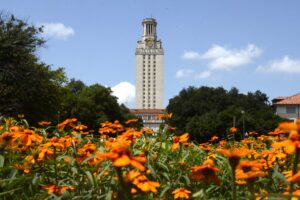AUSTIN, Texas—Diversity efforts at The University of Texas at Austin have brought a higher number of freshman minority students—African Americans, Hispanics and Asian Americans—to the campus than were enrolled in 1996, the year a court ruling ended the use of affirmative action in the university’s enrollment process.
A report by the university’s Office of Institutional Research for the 2002 fall/summer enrollment shows there were 266 African Americans, 932 Hispanics and 942 Asian Americans enrolled as first-time freshmen at the university in 1996. The numbers of African Americans and Hispanics dropped after the Hopwood ruling, although the figures for Asian Americans increased. In 1997, the numbers for first-time freshmen were down to 190 African Americans, 892 Hispanics and 1,130 Asian Americans.
More recent enrollment figures show a more encouraging trend. The summer/fall 2002 semester report shows that first-time freshmen enrollment for all three ethnic groups has increased to a level above the 1996 pre-Hopwood figures. Minority enrollment last fall included 272 African Americans, 1,137 Hispanics and 1,452 Asian Americans.
The university was forced to change its admission practices after a federal court ruling in a case that began in 1992 when law school applicant Cheryl Hopwood and others sued the university, claiming they were denied admission because the law school gave preferential consideration to black and Mexican-American applicants.
U.S. District Judge Sam Sparks ruled in 1994 that the law school could consider race in admission to maintain diverse enrollment or remedy past discrimination. The 5th Circuit Court of Appeals overturned the decision in 1996, ruling that any consideration of race, even as one factor among many, is unconstitutional. As a result of the court’s ruling, all affirmative action programs involving race and ethnicity in admission ended at public universities in Texas in June 1996.
The “Top Ten Percent” legislation (HB588) was enacted into law by the Texas Legislature in 1997 to assure the very best of each high school admission to the state university of their choice. The university also has taken other initiatives to encourage minority enrollment.
The decline in the Hispanic and African American freshman population in the first years after the Hopwood ruling resulted in a lower total number of minority undergraduate students in subsequent years. In 1996, the university’s undergraduate minority enrollment included 1,479 African Americans, 5,247 Hispanics and 4,459 Asian Americans. By 1997 the ethnic minority enrollment figures were 1,353 African Americans, 5,234 Hispanics and 4,783 Asian Americans.
The summer/fall 2002 undergraduate enrollment includes more Hispanic students (5,459) and Asian-American students (6,616) than in the last pre-Hopwood year. While there are still fewer African-Americans than in the last pre-Hopwood year by about 7 percent, the number of African-American undergraduates has been rebuilt from the low point in 1999, when the total was 1,277 students.
The rebuilding of diversity on campus also can be seen in the university’s School of Law, where minority enrollment before Hopwood included 97 African Americans, 179 Hispanics and 88 Asian Americans. After Hopwood, the 1997 figures were 67 African Americans, 145 Hispanics and 94 Asian Americans. The figures for Hispanics and African Americans dropped even more in subsequent years and reached a low in 1999 of 17 African Americans and 114 Hispanic law students.
The minority enrollment at the law school for the fall 2002 semester was 54 African Americans, 150 Hispanics and 87 Asian Americans.
At the graduate level, there is greater representation in 2002 of both Hispanic students and Asian-American students than in 1996. There has been a steady fall, however, in the number of African-American graduate students. The graduate student minority population in 1996 included 335 African Americans, 781 Hispanics and 442 Asian Americans. The totals in all groups fell in 1997 to 300 African Americans , 769 Hispanics and 423 Asian Americans. The report for fall 2002 shows 248 African Americans, 797 Hispanics and 586 Asian Americans.
The enrollment of white students at The University of Texas at Austin has increased on the undergraduate level but decreased on the graduate and law school levels since 1996. The summer/fall semester numbers for first-time freshmen were 4,159 in 1996, 4,730 in 1997 and 4,882 in 2002. The total number of fall undergraduates during those years were 23,345 in 1996, 24,219 in 1997 and 24,453 in 2002. Law school enrollment of white students was 1,115 in 1996, 1,089 in 1997 and 1,070 in 2002. The graduate school enrollment of white students was 6,886 in 1996, 6,761 in 1997 and 5,931 in 2002.
The Office of Institutional Research Web site provides a statistical handbook for the 2002-03 academic year that shows additional information about the university’s enrollment and demographics.
For more information contact: Robert D. Meckel, Office of Public Affairs, 512-475-7847.
The University of Texas at Austin
|
|||||||
Fall Enrollment of First-Time Freshmen – Fall and Summer (TABLE S12A/B) |
|||||||
|
Number
|
Percent Distribution
|
||||||
|
1996 |
1997 |
2002 |
1996 |
1997 |
2002 |
||
|
African American
|
266
|
190
|
272
|
4.1%
|
2.7%
|
3.4%
|
|
|
Hispanic
|
932
|
892
|
1,137
|
14.5%
|
12.6%
|
14.3%
|
|
|
Asian American
|
942
|
1,130
|
1,452
|
14.7%
|
15.9%
|
18.3%
|
|
Fall Enrollment – Undergraduate (TABLE S4A/B) |
|||||||
|
Number
|
Percent Distribution
|
||||||
|
1996 |
1997 |
2002 |
1996 |
1997 |
2002 |
||
|
African American
|
1,479
|
1,353
|
1,372
|
4.1%
|
3.7%
|
3.5%
|
|
|
Hispanic
|
5,247
|
5,234
|
5,459
|
14.7%
|
14.2%
|
13.8%
|
|
|
Asian American
|
4,459
|
4,783
|
6,616
|
12.5%
|
13.0%
|
16.7%
|
|
Fall Enrollment – Undergraduate (TABLE S4A/B) |
|||||||
African American – Number/Percent Distribution |
|||||||
|
1995
|
1,469
|
4.2%
|
|||||
|
1996
|
1,479
|
4.1%
|
|||||
|
1997
|
1,353
|
3.7%
|
|||||
|
1998
|
1,311
|
3.5%
|
|||||
|
1999
|
1,277
|
3.4%
|
|||||
|
2000
|
1,298
|
3.4%
|
|||||
|
2001
|
1,335
|
3.5%
|
|||||
|
2002
|
1,372
|
3.5%
|
|||||
Fall Enrollment – Law (TABLE S4A/B) |
|||||||
|
Number
|
Percent Distribution
|
||||||
|
1996 |
1997 |
2002 |
1996 |
1997 |
2002 |
||
|
African American
|
97
|
67
|
54
|
6.4%
|
4.7%
|
3.6%
|
|
|
Hispanic
|
179
|
145
|
150
|
11.8%
|
10.2%
|
10.1%
|
|
|
Asian American
|
88
|
94
|
87
|
5.8%
|
6.6%
|
5.9%
|
|
Fall Enrollment – Law (TABLE S4A/B) |
|||||||
African American – Number/Percent Distribution |
|||||||
|
1995
|
100
|
6.6%
|
|||||
|
1996
|
97
|
6.4%
|
|||||
|
1997
|
67
|
4.7%
|
|||||
|
1998
|
40
|
2.9%
|
|||||
|
1999
|
17
|
1.2%
|
|||||
|
2000
|
33
|
2.3%
|
|||||
|
2001
|
41
|
2.9%
|
|||||
|
2002
|
54
|
3.6%
|
|||||
Fall Enrollment – Graduate (TABLE S4A/B) |
|||||||
|
Number
|
Percent Distribution
|
||||||
|
1996 |
1997 |
2002 |
1996 |
1997 |
2002 |
||
|
African American
|
335
|
300
|
248
|
3.1%
|
2.8%
|
2.2%
|
|
|
Hispanic
|
781
|
769
|
797
|
7.3%
|
7.3%
|
7.2%
|
|
|
Asian American
|
442
|
423
|
586
|
4.1%
|
4.0%
|
5.3%
|
|
Source: The University of Texas at Austin 2002-03 Statistical Handbook



